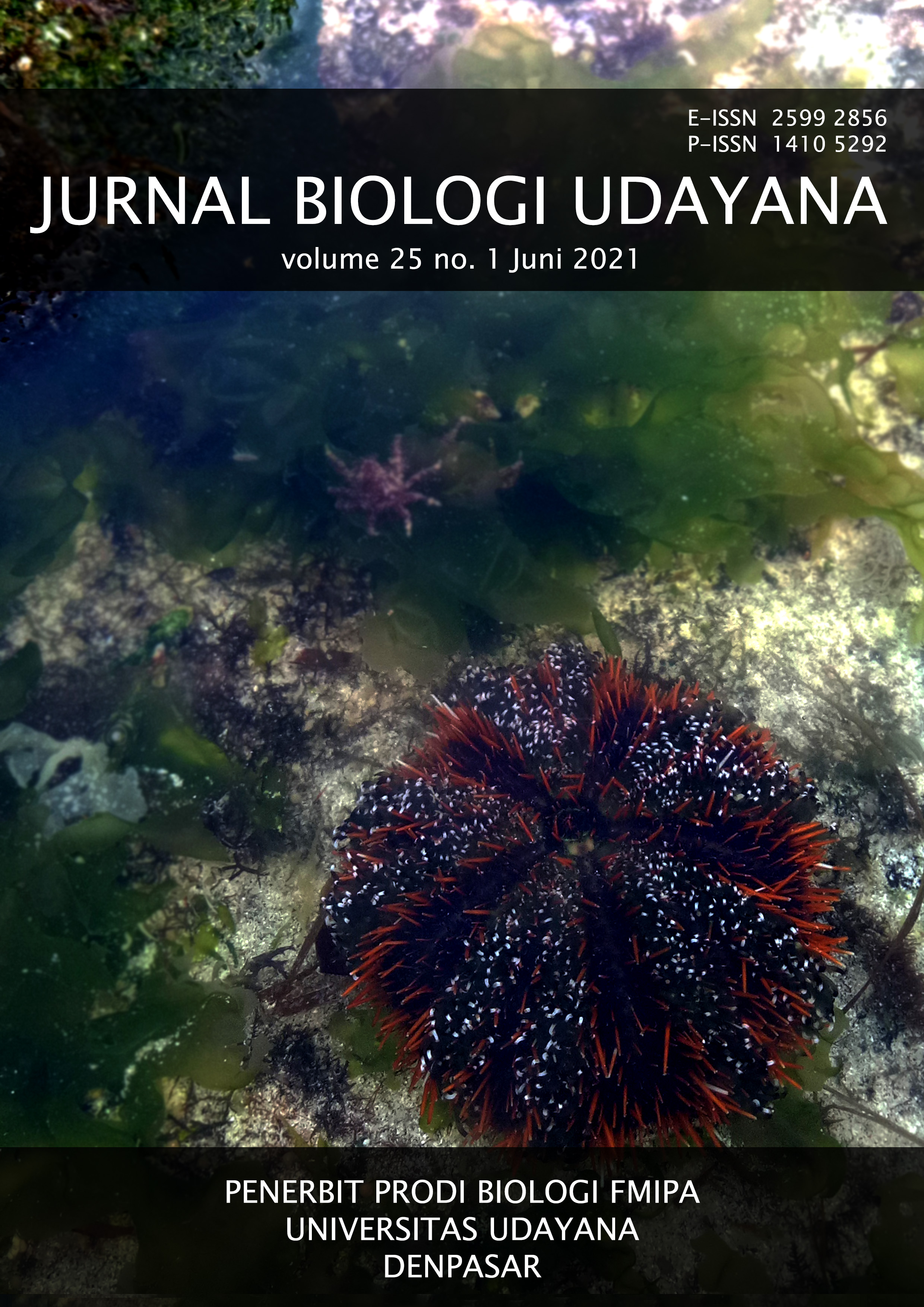Meta-Analysis: Effectiveness of artificial feeding to increase growth rate and reproduction quality of Monopterus albus species
Abstract
The use of artificial feed for fish farming has been widely used at this time, however, it is not yet known the significant effect of artificial feed on the growth and reproduction rate of Monopterus albus. This study aims to determine the effectiveness of artificial feeding on the growth and reproduction rate of Monopterus albus species. This research is meta-analysis research. The data source comes from a search of 18 national and international articles published in 2010-2020 related to feeding the Monopterus albus species. Data obtained from google scholar database, DOAJ, ScienceDirect, sagejournal, Springer, and IEEE. The data analysis technique is a qualitative descriptive analysis with JASP software. The results showed that 35% of artificial feeding affected the growth of Monopterus albus and 28.5% affected the reproductive rate with an effect size of 1.2. This shows that artificial feeding has an effect of 0.334 in increasing the growth and reproductive quality of Monopterus albus.
Downloads
References
Diatin I, Hadiroseyani Y, Astuti D. 2019. Monopterus albus dan Pengaruhnya terhadap profitabilitas. Jurnal Riset Akuakultur 14(3): 163–171.
Falahudin I, Mareta DE, Puspa RY. 2016. Pengaruh pemberian keong sawah dan air cucian beras terhadap pertumbuhan belut (Monopterus albus Zuieuw). Jurnal Biota 2(1): 112–119.
Feng K, Luo H, Li Y, Chen J, Wang Y, Sun Y, Zhu Z, Hu W. 2017. High efficient gene targeting in rice field eel Monopterus albus by tran- scription activator-like effector nucleases. Science Bulletin 8(7): 1–7. https://doi.org/10.1016/j.scib.2017.01.018
Fujiani T, Rahayu R. 2015. Laju pertumbuhan belut sawah (Monopterus albus Zuiew) dengan pemberian berbagai pakan the growth rate of swamp eel (Monopterus albus Zuiew ) under various food supply. Jurnal Biologi Universitas Andalas 4(1): 50–56.
Herawati VE. 2017. Analysis of different natural feed consupmtion on growth and survival rate of eel (Monoptherus albus ) in clear water. AQUASAINS (Jurnal Ilmu Perikanan dan Sumberdaya Perairan) 5(2): 1–6.
Herdiana L, Kamal MM, Butet NA, Affandi R. 2017. Keragaman morfometrik dan genetik gen coi belut sawah (Monopterus albus ) asal empat populasi di Jawa Barat. Jurnal Ilmu Pertanian Indonesia 22(3): 180–190.
Indrawan MA, Idris M, Pangerang UK. 2016. Pengaruh pemberian pakan dengan level protein berbeda terhadap pertumbuhan dan kelangsungan hidup belut sawah (Monopterus albus) pada media kultur tanpa lumpur. E. Media Akuatika 1(3): 161–169.
Kamta HN, Masyitha D, Zanuddin. 2018. Jumlah sel goblet pada usus proksimal dan usus distal belut sawah (Monopterus albus). JIMVET 2(1): 215–220.
Mashuri, Sumarjan ZA. 2012. Pengaruh jenis pakan yang berbeda terhadap pertumbuhan belut sawah (Monopterus albus Zuieuw) THE. Jurnal Perikanan Unram 1(1): 1–8.
Arief M, Nur F, Sri S. 2014. The present effect of different probiotics on commercial feed towards growth and feed efficiency of sangkuriang catfish (Clarias sp.) Jurnal Ilmiah Perikanan dan Kelautan 6(1): 49–53.
Muskita WH, Idris M. 2018. Pengaruh penambahan tepung cacing pada pakan formula terhadap pertumbuhan dan kelangsungan hidup belut sawah ( Monopterus albus ) yang dipelihara di media tanpa lumpur. Media Akuatika 3(3): 713–722.
Hasyim RAY, Arief M, Budi SR. 2017. Penambahan atraktan pada pakan pasta terhadap konsumsi pakan , retensi protein dan retensi lemak belut (Monopterus Albus) yang dipelihara dengan sistem resirkulasi. Journal of Aquaculture and Fish Health 7(1): 1–9.
Istiqomah S, Mirni L, Kustiawan TP. 2017. Potensi penambahan minyak ikan lemuru pada pakan komersial terhadap kandungan asam lemak omega-3 dan omega-6 daging belut sawah ( Monopterus albus ). Jurnal Ilmiah Perikanan Dan Kelautan, 9(1): 37–46.
Soelistyowati DT, Syarif AF, Affandi R, Hidayatullah D. 2017. Genetic variability and performance of Asian swamp eel Monopterus albus (Zuiew, 1793) from West Java cultured in saline water medium. Jurnal Akuakultur Indonesia 16(1): 33–40.
Suntronpong A. 2020. Characterization of centromeric satellite DNAs (MALREP) in the Asian swamp eel (Monopterus albus) suggests the possible origin of repeats from transposable elements. Genomics 112(5): 3097–3107.
Supiwong W. 2019. Karyotype diversity and evolutionary trends in the Asian swamp eel Monopterus albus (Synbranchiformes, Synbranchidae): A case of chromosomal speciation? BMC Evolutionary Biology 19(1): 1–9.
Syahputra H, Sudrajat AO, Soelistyowati DT. 2014. Pemaskulinan belut (Monopterus albus Zuiew 1793) dengan induksi penghambat aromatase untuk penyediaan calon induk jantan. Jurnal Iktiologi Indonesia 14(2): 157–165.
Xia L. 2018. Molecular cloning and functional analysis of IRF-1 in the asian swamp eel (Monopterus albus). Turkish Journal of Fisheries and Aquatic Sciences 18(12): 1421–1430.
Xiang J, Qin L, Zhao D, Xiong F, Wang G, Zou H, Li W, Li M, Song K, Wu S. 2019. Growth performance, immunity and intestinal microbiota of swamp eel (Monopterus albus) fed a diet supplemented with house fly larvae (Musca domestica). Aquaculture Nutrition 6(3): 1–12.
Yang D. 2018. Aquaculture of the paddy eel, Monopterus albus. In Aquaculture in China: Success Stories and Modern Trends (pp. 283–296).
Yusriadi A, Idris M, Patadjai RS. 2017. Pengaruh pergantian air terhadap pertumbuhan dan kelangsungan hidup belut sawah (Monopterus albus) yang dipelihara pada media tanpa lumpur. Media Akuatika 2(4), 519–525.
Zwinderman TJ, C AH. 2010. Modern meta-analysisis.Springer International Publishing.





